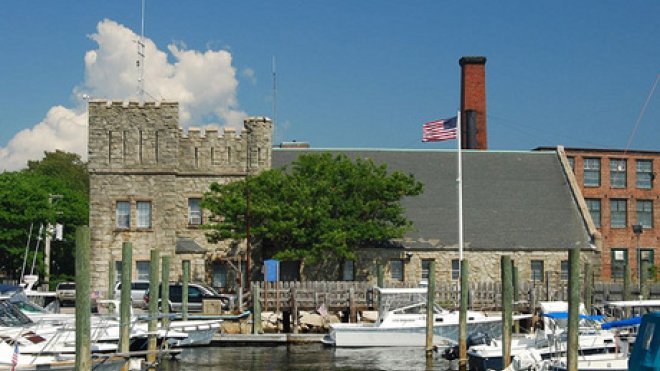Partners on a Port of Welcome
Through the Community Partnerships Center, RWU students develop a plan to boost Bristol economy, tourism by transforming a historic Naval Armory into a Maritime Welcome Center

Visiting boaters sail into picturesque Bristol Harbor ready to see the sights, visit museums and shop around town – but without a place to welcome them and guide them to these local gems, many visitors end up wandering aimlessly about the port. When the Town of Bristol asked for help, Roger Williams University stepped in to lend a hand.
Brought together through the RWU Community Partnerships Center, students from the Mario J. Gabelli School of Business teamed up with architecture and construction management students to study the feasibility of transforming a historic Naval Armory on the Bristol waterfront into a maritime center that would serve as a welcoming hub and visitor’s center for out-of-town boaters.
Throughout the fall semester, the students met with members of the community to determine what the town wanted to achieve with such a facility, and visited Newport’s Maritime Center to see first-hand how maritime welcome centers operate. Research of town records affirmed that visitor moorings and slips are greatly underutilized and could provide a better source of revenue to the town. With this knowledge, the students prepared a business plan and designs to demonstrate how a maritime center would benefit the whole town, and that, through grants and donations, it could be done for minimal cost – two key criteria to move forward the development of the project.
On Wednesday, February 13, the students presented their ideas to the Bristol Town Council.
“We looked at whether it is feasible to build, how would it economically affect Bristol, and would it promote economic growth,” said economics major Macy Miller.
Once it seemed the project was both economically feasible and beneficial, the students looked at the marketing side.
“How do you bring people into Bristol?” marketing major Haley O’Callaghan asked at the council meeting. “We really want to emphasize it as a destination – it’s a historic town, it’s beautiful. You want to create a sense of welcome to downtown Bristol.”
Henry Kniskern, a Gabelli School of Business adjunct faculty member and lead advisor for the project, told council members that as they were developing these preliminary plans, many questions arose that can be studied in the second phase of the project, from the potential for year-round use to establishing it as a site that builds “urban energy,” á la the Providence Waterfire program.
Their presentation was warmly received by the town council members, who thanked the students and faculty members for their hard work on the project.
Director of Community Development Diane Williamson, with whom the students worked closely on the project, called this “another great project with the CPC.” She said the students acted “very professionally” throughout the project.
With the Bristol Town Council’s blessing, the students will now move into the second phase of the project and focus on developing a comprehensive marketing plan and further study of how best to use the site and incorporate it into the expansion of the harbor.
“I’m really optimistic about a great project coming out of this,” Williamson said.